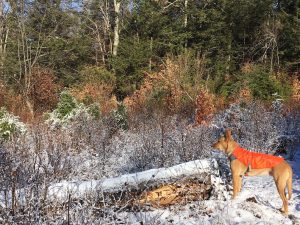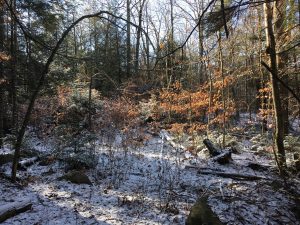By Tamsin Flanders, MassLIFT Land Stewardship Coordinator ’16-‘17
In 2016 HLT received a grant through the Foresters for the Birds Program (a partnership of the Massachusetts Department of Conservation and Recreation, Massachusetts Audubon, and Mass Woodlands Institute) to revise the forest management plan for our Stevens property. The grant helped pay for a forester to assess the quality of and suggest improvements to existing woodland bird habitat for priority woodland-breeding bird species in MA. On a bright day last November I joined forester and former HLT board member Lincoln Fish and his dog Macy on the property for the assessment hike.

The 287-acre Stevens property, which straddles the Huntington/Westhampton line north of Route 66, already strongly supports moose, deer, and porcupine habitat. It boasts a diverse range of forest types and ages, some of which were created 10 years ago by a timber harvest Lincoln oversaw. Given its size, HLT would like to continue to conduct timber harvests on Stevens that will demonstrate habitat management and harvest techniques.
The long- and short-term goals of the Foresters for the Birds Program are “to provide healthy forests that provide suitable breeding and post-breeding habitat conditions for a suite of Massachusetts birds that through sustained, careful, and long-term management can also support timber harvests.” The idea behind a bird habitat-based management plan is that stand-level (1 -5 acre) treatments, done over time, will allow the forest to achieve 70% forest cover on the property or landscape scale that include large contiguous forest blocks and are composed of a diversity of forest age classes. These goals are generally achieved by encouraging a mature forest with patches of young regenerating forest.
As Lincoln and I hiked through the various forest types we primarily looked at forest canopy structure. Within mature forests, it is beneficial to the diversity of bird species for there to be varied forest structure that includes canopy, mid-story, understory, and ground layers.

Many bird species need mid-story canopy, including the Veery, which needs it for nesting. Almost half of the time we noted young beech or hemlock that provided mid-story canopy in an otherwise mature forest. Deep into the property, near the top of Mt. Pisgah, we found a hardwood pole forest that offered very consistent hardwood mid-story canopy and plentiful Mountain Laurel, excellent canopy and cover.
Moving down the canopy ladder, we found a few patches of low canopy forest, including a small forest of hemlocks 1 – 2 feet high near the low-lying portion of the property defined by Pitsinger Brook. Birds such as Black-Throated Blue, Black-Throated Green, Canada, and Chestnut-sided Warblers, all of whom nest in low canopy or need this forest level to hide their nest and themselves from predators. Downed woody debris serves a similar function and was present on the property as with any mature forest.
Needing to record the percentages of open and closed canopy, we noted that most of the property is closed canopy, aside from the patch cuts created 10 years ago. Ovenbird, Black-Throated Green Warblers, and Brown Creepers are birds that depend on closed canopy with small gaps.
We also checked on all of our timber cuts from 2006. One of those cuts was a two-acre patch cut that was entirely harvested and has grown back very minimally in ten years—the majority of the trees are less than 4 feet tall—due to heavy moose and deer browse. Patches like this constitute young forest—1+ acres of dense, regenerating forests. Their high stem-density provides cover favored by American Woodcock and Ruffed Grouse, and abundant insect forage for many species. Young forest has to be created in modern times as the flooding and fires that once were the cause of young forests are now prevented by human management. Birds favoring these dense, brushy habitats thus depend on active forest management.

Very often we took note of individual tree species. We found a few poplars, for example, which are a key species for Ruffed Grouse. The hemlock grove we crossed at the top of Pitsinger Brook constituted a softwood inclusion, great habitat for Black-Throated Green Warblers, Blackburnian Warblers, and Blue-Headed Vireos. There were a few ‘habitat trees’ noted—large diameter trees with cavities that provide nesting sites for owls and woodpeckers. Large-diameter, structurally-sound trees are also good stick nest sites for woodland raptors, such as Sharp-shinned Hawks.
Finally, we also kept our awareness on leaf litter. Leaf litter is important for Oven Birds, ground nesting birds that construct small cob-oven shaped nests from leaves. Other birds such as Wood Thrush and Eastern Towhee need leaf-litter to forage for soil macro-invertebrates. Most of the property is dominated by hardwood, so the property scored well on leaf-litter.
As a result of this assessment, the new forest management plan with birds in mind recommends that HLT cut a few patches 0.1 – 2 acres in size along topographical lines in order to create new areas of low and mid-story forest. This could create the secondary benefits of opening up a view and hopefully encouraging the growth of desired hardwoods such as oak and maple. Maintaining brushy habitat where it already exists, and creating it intermittently between forested patches by selective thinning are another recommendation of the plan. Lastly, the plan recommends selective cutting to release oaks and black cherries in the pole forest so as to allow the oaks to mature (maintaining species diversity), while creating a new generation of understory.
Like most good forest management plans, the new proposal aims to generate multiple beneficial outcomes. In addition to the creation of bird habitat, if done properly, these treatments may also increase the value of the timber stand, benefit human recreation, and improve mammalian habitat.
An avid birder, I was delighted to have had the opportunity to accompany Lincoln Fish on this assessment. Hilltown Land Trust appreciates being reminded again that active forest management creates some of the best habitat, and we look forward to following the recommended improvements with the next timber harvest on the Stevens property.
For more details about the grant and about bird species highlighted in this assessment visit http://masswoodlandsinstitute.org/programs/foresters-for-the-birds.
